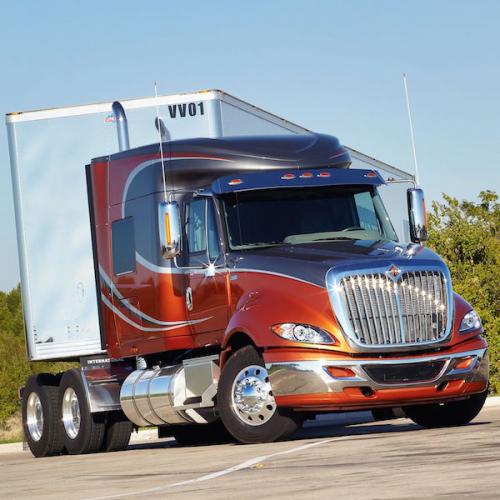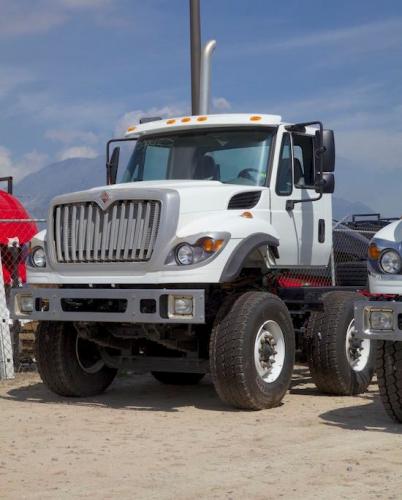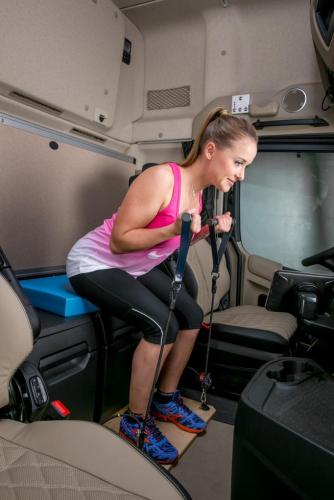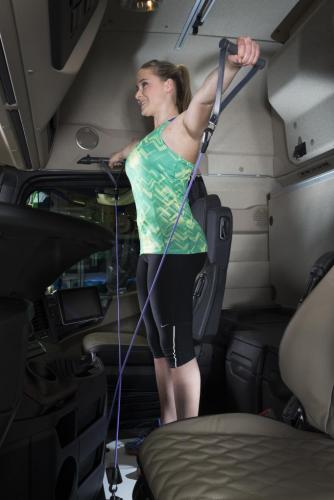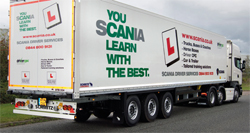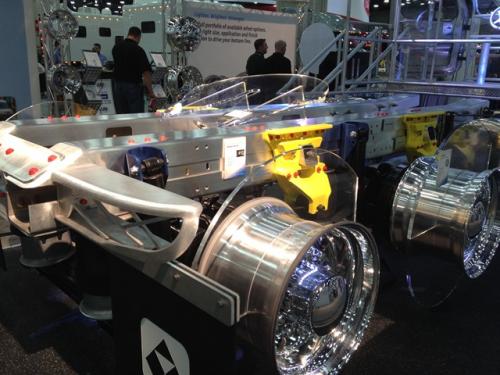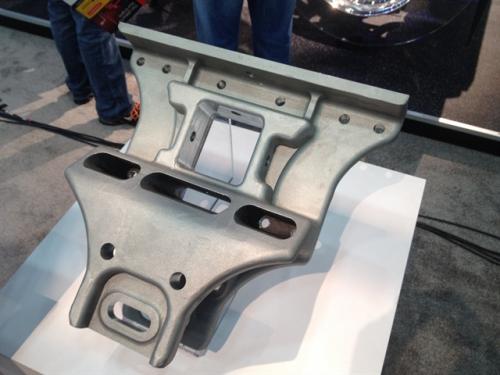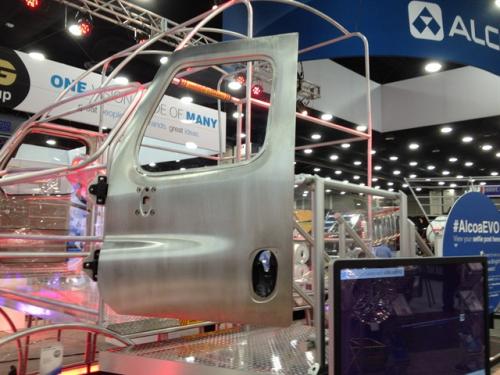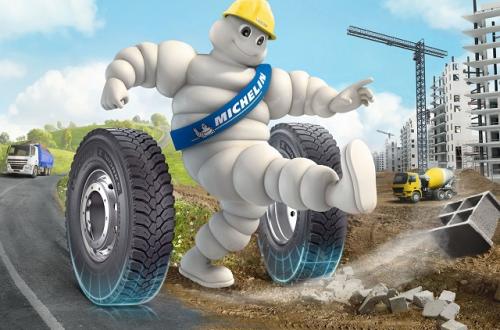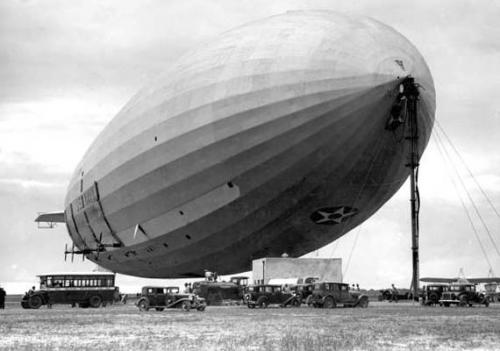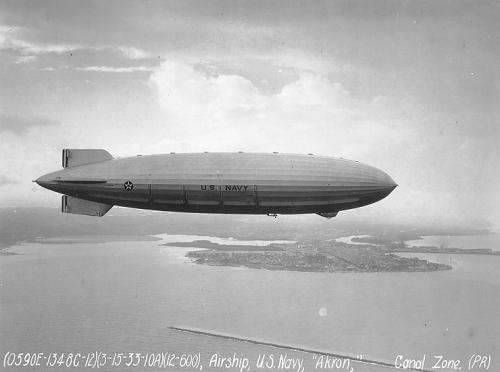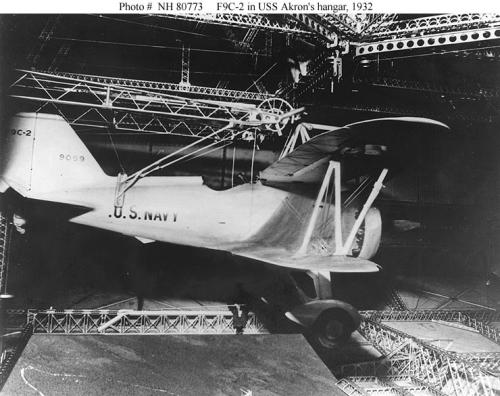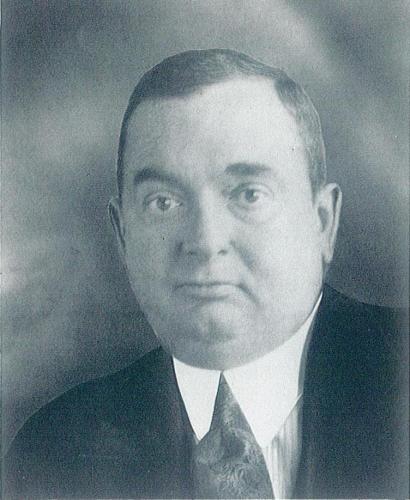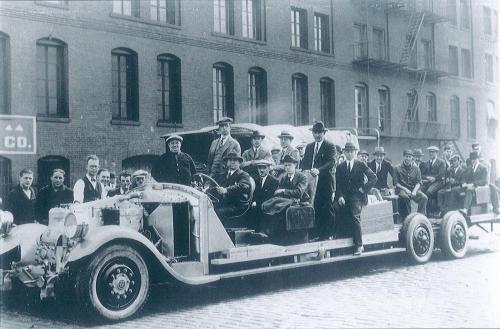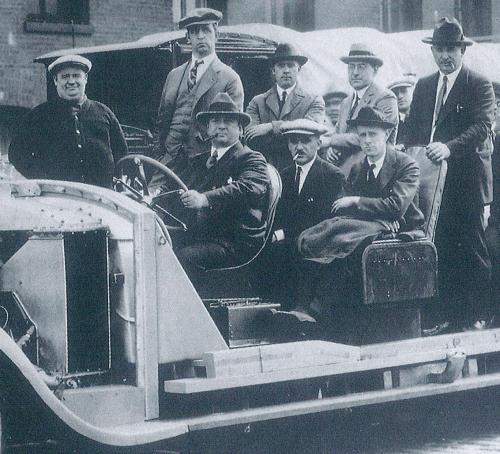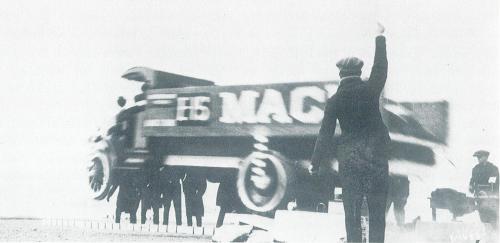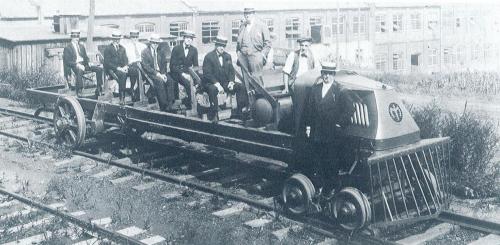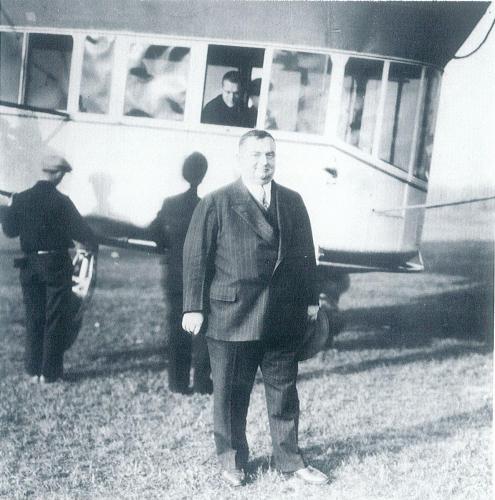
kscarbel2
Moderator-
Posts
18,915 -
Joined
-
Days Won
114
Content Type
Profiles
Forums
Gallery
Events
Blogs
BMT Wiki
Collections
Store
Everything posted by kscarbel2
-
I can understand CNG in the package car application*, however LNG is better than CNG in a tractor application (http://www.agilityfuelsystems.com/lng-vs-cng.html). UPS's issue with LNG is that CNG is taxed on a per GGE (Gasoline Gallon Equivalent) basis, while LNG is taxed on a per liquid gallon basis. When both are converted to diesel gallon energy equivalents, CNG is fairly taxed but LNG is not. LNG has a tax rate of approximately 41 cents per gallon, while CNG has a 24 cents per gallon tax rate. The 17 cent disadvantage to using LNG users is ridiculous. Washington claims they want to promote clean air, and yet they make LNG truck operators pay more. UPS has also ordered 445 model 160 DGE behind-the-cab CNG fuel systems from Agility Fuel Systems (http://www.agilityfuelsystems.com/behind-the-cab.html). Back in the day, UPS used to save money by standardizing to a large degree. But with their natural gas equipment, they have created a maintenance director's nightmare by ordering a bit of everything under the sun. It would be more cost effective to simply standardize on the LNG Cummins-Westport ISX12G. * Freightliner Custom Chassis (Morgan Olson bodies) powered by GM 6.0-liter Vortec V-8 engines converted with Landi Renzo CNG systems.
-
Mack Defense Awarded General Services Administration Contract Trailer/Body Builders / April 9, 2015 Mack Defense has been awarded an indefinite delivery/indefinite quantity contract from the General Services Administration (GSA) under which Mack Defense will supply Mack Pinnacle, Mack Granite and Mack TerraPro models from now until Oct. 31, 2015. GSA has the option to extend the contract for an additional year through Oct. 31, 2016. The GSA contract also includes natural gas-powered vehicles from Mack. Mack offers the natural gas-powered Pinnacle highway model, which runs on either compressed natural gas (CNG) or liquefied natural gas (LNG). “We look forward to working with the GSA to fulfill our contract with natural gas-powered and diesel-powered Mack vehicles,” said Ryan Werling, president of Mack Defense. “Mack is known for its products, all of which are built in the U.S.A., and we are excited to offer natural gas-powered solutions for our government customers looking for alternative-fuel vehicles. We are pleased that Mack is the only OEM under the contract to offer heavy-duty natural gas vehicles.”
-
Diesel News Australia / April 10, 2015 This week Navistar Auspac, the company which imports Cat Trucks into Australia. has announced their plans to make an announcement at Brisbane Truck Show. The company will outline its plans for the reintroduction of the International Trucks brand into Australia. Navistar are keeping their powder dry and unwilling to flesh out any details in advance. The comeback for International was revealed in the November/December 2014 issue of Diesel Magazine, at a point when Navistar were still grappling with decisions about which models to bring in and where to sell them. Apparently, those issues are now settled and the company are committed to the new brand. There will be a teaser, and some more information, on the stand in Brisbane, before an introduction of the models into Australia in 2016. There is bound to be a good deal of interest in International from the trucking industry. It is an iconic Australian brand and alongside Ford, dominated the truck market in the late 20th century. The false dawn of the reintroduction of International ten years ago dwindled several years ago, but now the truck manufacturer is back in its own right. The question in many minds is, which models will we see coming off the boat later this year for the 2016 relaunch? The flagship for the brand in the US is the Lonestar, an iconic and instantly recognisable heavy duty prime mover designed for the owner driver. In fact, the model has also sold well into fleets in the US, a truck with plenty of bling helps with driver retention. The chances of this truck arriving in serious numbers is quite low. The cost of redesigning for right hand drive and getting the brittle front grille protected from Aussie roads looks to make the LoneStar an expensive option. However, if you are going to reintroduce the International brand to Australia, the LoneStar is the kind of headliner to bring a big bang to the show. It will certainly turn heads and tell everyone International is back. The ProStar is the go-to prime mover for many large fleets in the US. It is a proven performer, in terms of durability and fuel economy. However, it is also the model from which the current Cat brand on sale in Australia derives. This could create some conflicts for Navistar in terms of brand definition between Cat and International. There can be some differentiation. You can buy the Cat version with a C 15 engine or a 13 litre alternative, or you can go for the International model with the same basic cab, but with a Cummins ISX engine. Back to the old red vs yellow rivalry! The segment of the truck market in Australia where the ProStar would work is where the big sales numbers are. It can be sold all the way from a cheap fleet spec right up to the blinged up fit-out of the owner driver, set up as a single trailer prime mover or, at a higher power rating, as a B-double prime mover. You pays your money…. There is a more rugged vocational heavy prime mover model, with the PayStar, on the US market. The truck is very reminiscent of the 9200 models built and sold in Australia by Iveco ten years ago. Power comes from an International 13 litre or the Cummins ISX platform. This model is probably not modern enough to fit with the image Navistar will be trying to project in Australia. Another contender to be one of the first out of the box is the WorkStar. This is the latest, and much more modern, iteration of the model sold here as the 7600, for a short time. The truck is available in an extremely wide range of configurations and options in the US. It is sold all the way from a 4×2 to an 8×6 model and power options vary from the 13 litre International engine (already sold here as the Cat CT 13) all the way through an 11, 10, 9 litre International or a Cummins ISB. Configurations are set up for tipper, agitator, prime mover, garbage and other applications. Could this model find a home in Australia? Most probably, and the breadth of the specifications possible means Navistar should come up with a few specs ideally suited to our market. There’s also an 8×4 available, but load sharing suspension could be an issue. Getting into the lighter end of the market may be a long term aim for Navistar, but unlikely to be the Americans’ first port of call. There are a couple of models which may come into contention. The DuraStar is normally sold as a 4×2 but can be ordered as a 6×4. Power can either come from a Cummins ISB 7 litre or the 9 litre International engine. The wide range of options available do make this a possibility. It is not the world’s prettiest truck, but does look functional. It remains an outsider for introduction. The International TerraStar is unlikely to see the light of day, as it plays in the area totally dominated by the Japanese trucks in Australia. It is a medium duty truck with a conventional cab designed to look like a smaller version of the heavier ranges. Power comes from the 7 litre Maxxforce engine. This truck can be seen in large number on the streets of US cities but would be unlikely to make much of a mark here. One option sold by International in Mexico is very unlikely to get a guernsey here. The CityStar* is a light duty cabover, made in China by JAC Trucks, as part of a deal between Navistar and the Chinese truck maker. * http://www.internationaltrucks.com/mexico/camiones/citystar .
-
Press Release / April 9, 2015 Sport and fitness set developed for use in truck cabsMercedes-Benz Trucks actively conducts research for the health and fitness of driversTraining videos free of charge on the web and in the FleetBoard Driver.appTopFit Set suitable for use in all truck brandsHealthy drivers are indispensable for an efficient transport sector Mercedes-Benz Trucks is now offering the “TopFit Set” as a genuine accessory for truck drivers who want to do something positive for their health while on the road. Designed and developed specifically for use in truck cabs, the set enables the parts of the body most subject to stresses in the professional working day of drivers to be strengthened, toned and kept fit. According to a 2012 study by the Robert Koch Institute, around 80 percent of the German population suffer back ailments during the course of their lives, and in many cases these are also chronic. During a health monitoring survey by the research institute in March 2014, some 20.7 percent of adults in Germany reported that in 2013 alone, they had suffered chronic back pain at least once. Chronic back pain is defined as pain that persists for at least three months or longer, on an almost daily basis. Germany has backbone. This is also the subject of a recent 2014 health report produced by the technical health insurance fund, which surveyed back ailments and the resulting absences from work. According to this, younger employees are also frequently afflicted with these ailments, which can seriously affect quality of life and the ability to work. The professional group of drivers of vehicles and transport equipment has an average sick rate of 24.1 days. A top score – in a negative sense. Truck drivers need a fitness package “to go” Ultra-modern trucks such as the Actros already have the best possible features for their drivers. Useful assistance systems, comfortable seats and well-designed beds are just some of them. Nonetheless, sitting for long periods of time is physically highly stressful, even though this often goes unnoticed - after all, all you are doing is “sitting”. However, it is just such a passive physical posture that places great stress on the muscles and spinal column if there is no compensating movement. In that case there is inadequate circulation to the blood vessels, muscle fibres and joints. The vertebral discs lose their elasticity, and the groups of muscles in the neck and in the upper and lower back, which have to support a weakened spinal column, stiffen up and begin to hurt. This is particularly serious for professional drivers, as when they are on a tour they are unable to visit a gym for example at the end of the day as a preventive measure, or seek out a physiotherapist at short notice when acute back pain sets in. The TopFit Set allows a tailor-made fitness programme while on the road The set includes a board of robust plywood to which two metal eyelets are attached. The rubber training straps known as tubes are attached to these with a spring clip. The board also acts as a standing surface. The user puts his/her bodyweight on the board, and with dimensions of 65 x 40 centimetres it fits perfectly on the floor surface between the seats – not only in the Actros, but also in any truck model with a level floor. The board comes with two pairs of tubes with different levels of training resistance. These are made from a special rubber formulation and have a constant rate of elasticity. This means that individuals of different sizes can train with the set, as the effort required remains constant however far the tube is stretched. The set is completed by a pair of flexible, ergonomic handles which rotate to follow the movements and thereby reduce wrist tension, plus a useful carrying bag. In the future there will also be further tubes with different resistances available as additions to the set. “We specifically developed our TopFit Set for use in a truck cab”, says Siegfried Rothe, a customer researcher and developer at Daimler. “Using the fitness board, drivers can exercise in the privacy of their cab – an important factor for many truckers”.The positive effects of this exercise activity are noticeable to the driver as a greater feeling of well-being, less fatigue when sitting at the wheel on a journey, a possible weight reduction and above all a considerable reduction in back pain in the case of existing ailments. Workouts free of charge on the web, and from May in the FleetBoard Driver.app Incidentally, Rothe and his research & development colleagues do not leave purchasers of the TopFit Set to fend for themselves afterwards: he has produced four exercise videos in close cooperation with sport scientists. The workouts “Basic Fit”, “Strong Fit”, “Top Fit” and “Power Fit” each contain six exercises aimed at the relevant areas of the neck, shoulders, upper arms, abdomen and upper/lower back. The training videos are on a DVD supplied with the set, and are also in the so-called “Fitness Coach” as part of the Android-based FleetBoard Driver.app. This also has a great deal of information and hints on the subject of “fitness and health while on tour”. The app will be available free of charge from the Google Play Store from May. Healthy drivers are indispensable for an efficient transport sector With the market launch of the TopFit Set as a Mercedes-Benz genuine accessory, Daimler is actively involving the driver at the wheel as a key factor. Because even the most modern trucks can go nowhere without drivers who are fit, healthy and well-motivated..
-
Mack produced a 7-speed overdrive Maxitorque transmission designated TRDLG-1070. You split 4th and 5th gears.
-
The Morning Call / April 8, 2014 Mack Defense of Allentown has won a contract to supply trucks to the U.S. government, the company announced Wednesday. Under the terms of the contract from the General Services Administration, Mack Defense, which is affiliated with Mack Trucks, will provide an indefinite number of Mack Pinnacle, Mack Granite and Mack TerraPro models through Oct. 31. The deal is worth $27 million, according to public records cited by Michael Scheid, a senior analyst with transportation consulting firm SJ Consulting Group in Sewickley, Allegheny County. "It's not insignificant, but it's not huge," Scheid said. The GSA contract, which the administration has the option to extend by a year, also includes natural gas-powered trucks. Mack offers a natural gas-powered Pinnacle highway model, which runs on either compressed or liquefied natural gas. "Mack is known for its products, all of which are built in the USA., and we are excited to offer natural gas-powered solutions for our government customers looking for alternative-fuel vehicles," Mack Defense President Ryan Werling said in a news release. "We are pleased that Mack is the only [supplier] under the contract to offer heavy-duty natural gas vehicles." It is unclear where the trucks will be made. Though Scheid said he believed the trucks will be made in Lower Macungie, phone calls to the company for confirmation were not returned. Mack Defense, created in 2012, is part of Volvo Group, a Swedish company that employs about 100,000 workers worldwide, including roughly 1,000 at its Mack Trucks plant in Lower Macungie. Volvo, which sold its car division to Ford Motor Co. in 1999, is one of the world's top truck makers. In Europe, Volvo trucks also sell under the Renault Trucks brand, and the company's other businesses include buses, construction equipment and engines.
- 1 reply
-
- 2
-

-
Transport Topics / April 8, 2015 Daimler Trucks North America is recalling some model-year 2015 Freightliner and Western Star trucks due to a possible brake problem, the National Highway Traffic Safety Administration said in a recall announcement. The agency said the affected vehicles may experience brake drag due to an improperly seated diaphragm in the brake chamber. “While traveling at highway speeds, brake drag may cause loss of vehicle control, increasing the risk of a crash,” NHTSA said. The models in the recall include Freightliner Cascadia, Business Class M2, 108SD, 114SD, 122SD, Coronado, Western Star 4700, and Western Star 4900 trucks manufactured Oct. 6, 2014, to Feb.16, 2015, and equipped with Haldex Life Seal brake chambers, NHTSA said. The number of potentially affected trucks is 2,386, DTNA said. DTNA will notify owners, and dealers will replace the brake chambers free of charge. The recall is expected to begin May 25. Owners may contact DTNA customer service at 1-800-745-8000. DTNA's number for this recall is FL676.
-
FedEx takeover creates tougher competitor for Toll, Australia Post Financial Review / April 8, 2015 FedEx's $6.3 billion takeover of rival courier group TNT Express will create fresh challenges for Australia Post and Toll Holdings as the Australian logistics group finalises its own sale to Japan Post. The US's FedEx plans to complete its acquisition of the Netherlands' TNT Express in the first half of the year if the proposed deal, which was announced in the US and Europe on Tuesday, is approved by regulators. Toll, which agreed in February to be acquired by Japan Post for $6.5 billion, has been planning on taking advantage of the Japanese group's transportation management skills and technology to boost its domestic delivery business, and compete more aggressively with Australia Post in delivering parcels ordered online. But FedEx – which is already the world's fourth largest logistics company behind Deutsche Post, the US Postal Service and UPS – will become an even stronger competitor in Australia if its purchase of TNT Express goes ahead. "Market shares will shift significantly in the next 12 to 18 months," said Ross MacMillan, Asia Pacific head of industrial equities research at Morningstar. "Australia Post has the most to lose but Toll has a real battle on its hands as well." Toll currently dominates the local market for courier pick up and delivery services with an 8.8 per cent market share, ahead of DHL Express, which has a 6.7 per cent market share, according to IBISWorld. The local market, which has $5.3 billion in annual revenues, is highly fragmented, with TNT Australia, FedEx, Star Track Express (owned by Australia Post) and UPS all having shares less than 5 per cent. Market share changes TNT declined to comment on how its proposed merger sale would change its market share. TNT's Australian business made a pre-tax loss of $17.7 million in 2013 while FedEx's Australian business made a pre-tax profit of $48.7 million in the same year, according to IBISWorld. FedEx increased its local pre-tax profit to $72.5 million in 2014. FedEx's US executives have already signalled that they plan to use the TNT acquisition to create a more efficient global network, reducing pickup and delivery costs, particularly with international parcel deliveries acquired through online shopping. "We think there is a tremendous opportunity in cross-border e-commerce," FedEx's global executive vice president of market development and corporate communications, Michael Glenn, told analysts this week. FedEx does not currently provide domestic express services in Australia and is focused solely on the international market. It uses its own aircraft to fly between Sydney and a regional hub in Guangzhou, where packages are sorted for delivery elsewhere to the world, and also uses commercial aircraft. But it operates 250 trucks and vans in Australia, and has couriers in most capital cities as well as Newcastle and Wollongong. FedEx is keen to take advantage of TNT's vehicle network as consumers opt for cheaper forms of delivery via trucks and ships instead of more expensive air services. Toll shareholders are due to vote on the proposed sale of the company at $9.04 per share to Japan Post on May 13. Independent experts Grant Samuel have estimated the full underlying value of Toll at between $8.22 and $9.10 per share.
-
Trucking Magazine / April 7, 2015 Schmitz Cargobull has supplied four 13.6 m box body trailers to Scania (Great Britain) Ltd for use in its driver training department. The S.KO FP25 trailers are part of a refreshment and expansion programme, bringing the total number of trailers in Scania’s training fleet to six. The SC trailers have been deployed across the UK, with individual assets operating from training sites in Avonmouth, Purfleet, Worksop, Newbridge, Milton Keynes and Glasgow. Scania is using the trailers to train new C+E drivers, which it said is becoming a growth market as more 3PLs seek to invest in ‘warehouse to wheels’ schemes to tackle the industry-wide driver shortage. “We selected Schmitz Cargobull because the build quality is so good and we know we can rely on them for support and maintenance,” said Scania (GB)’s driver development manager, Mark Agnew. “We plan to run these trailers for 10 years, so we need to be able to trust they will last. Plus, we know Schmitz Cargobull trailers have a great residual value, so they are extremely cost-effective for our business.” The box trailers are equipped with a range of standard equipment, including ferry shackles and load-restraint tracks inside the cargo area. Scania (GB) trains around 1000 drivers each year. Training takes place on vehicles in a semi-loaded state – each of the new trailers will carry a payload of up to eight tonnes. .
-
UPS drops bid to buy TNT Express Fleet Owner / January 15, 2013 United Parcel Service, Inc. (UPS) has abandoned its $6.9-billion (€5.2-billion) attempt to acquire Amsterdam-based TNT Express NV (TNTE). The Dutch firm is the second-largest package delivery firm in Europe and also has operations in emerging markets. UPS initiated the bid last March to better compete in Europe with the continent’s largest-package delivery operation, Deutsche Post’s DHL. UPS wanted to buy TNTE both for its European network and its assets in Asia and Latin America, Reuters reported. UPS announced yesterday that the European Commission (EC) had “informed UPS and TNTE that it is “working on a decision to prohibit the proposed acquisition of TNTE” as it determined the takeover would make the business sector less competitive by reducing the number of players serving it. TNTE stated that on January 11, it and UPS “met with EC’s case team investigating the proposed acquisition… The case team informed the companies that on the basis of UPS’s current remedy proposal it is working towards proposing a prohibition decision.” Responding to the EC’s concern, UPS had offered to sell parts of the company’s small package operations and airline assets, as reported by the Associated Press. Rival firms FedEx and DHL had both lobbied the EC to stop the takeover, a banking source told Reuters. However, UPS and TNTE failed to secure buyers and the planned asset sales were not enough to satisfy European Union officials. “One of the key sticking points to the proposed UPS/TNTE deal falling through was that UPS/TNTE were not able to find a buyer for certain assets that needed to be sold off in order to meet the EC's competition requirements,” pointed out analyst Peter Nesvold of Jefferies & Co. He also said that “UPS, the most likely buyer of those assets, did not get involved and indirectly helped the deal fall through.” Although UPS must pay TNTE a $265.5-million (€200-million) termination fee, the European firm remains on shaky ground. The news caused to its share price to fall at one point yesterday by 50% before closing 42% lower. In a statement, TNTE said it “regrets this situation, having believed the merger was feasible and beneficial for all stakeholders.” The company also said the “protracted merger process has been a distraction for management” and that “management will provide an update on its strategy in due course.” “We are extremely disappointed with the European Commission’s position,” said UPS CEO D. Scott Davis in a statement. “We proposed significant and tangible remedies designed to address the European Commission’s concerns with the transaction. “The combined company would have been transformative for the logistics industry, bringing meaningful benefits to consumers and customers around the world, while supporting growth in Europe in particular,” Davis added.
-
Fleet Owner / April 7, 2015 In a move that will surely realign the global parcel delivery market, FedEx Corp. plans to buy TNT Express N.V. in a $4.8 billion cash deal. Both firms noted in a statement that they expect to wrap up the acquisition within the first six months of 2016 and don’t foresee any major anti-trust complications. Both FedEx and TNT also agreed to several caveats as part of this deal: Existing employment terms of TNT Express will be respected;.The European regional headquarters of the combined companies will be in Amsterdam/Hoofddorp in the Netherlands;TNT Express’ hub in Liege, Belgium, will be maintained as a significant operation for the group going forward;TNT Express’ airline operations will be sold off, in compliance with applicable airline ownership regulations.“We believe that this strategic acquisition will add significant value for FedEx shareowners, team members and customers around the globe,” noted Frederick Smith, FedEx’s chairman and CEO, in a statement. “This transaction allows us to quickly broaden our portfolio of international transportation solutions to take advantage of market trends – especially the continuing growth of global e-commerce – and positions FedEx for greater long-term profitable growth,” he added. While Tex Gunning, CEO of TNT Express, noted that his company was “fully geared to execute our stand-alone strategy” and “did not solicit an acquisition” proposal, he believes the FedEx deal is a good one for all involved. “We truly believe that FedEx’s proposal – both from a financial and a non-financial view – is good news for all stakeholders,” Gunning said in a statement. “Our people and customers can profit from the true global reach and expanded propositions, while with this offer our shareholders can already reap benefits today that otherwise would only have been available in the longer run.” This deal also follows an aborted attempt by United Parcel Service to acquire TNT Express nearly two years ago; a deal nixed by the European Commission over anti-competitive issues. Both FedEx and TNT Express highlighted several strategic advantages to their dea, should it be approved: Their customers should enjoy broader global access via a “considerably enhanced” integrated global network;Specific advantages include the alignment of TNT Express’ European road platform and Liege hub with FedEx’s operations around the world, especially North America and Asia;TNT Express customers would also benefit from access to the FedEx portfolio of solutions, including global air express, freight forwarding, contract logistics and surface transportation capabilities;FedEx plans to keep strengthening TNT Express with investment capacity, sector expertise and global scope..
-
Prime Mover Magazine / April 7, 2015 Navistar Auspac has announced that the international truck brand will make its return to the Australian market in 2015. “Bringing International back to the Australian market is a key part of our growth goals for Australia and demonstrates our commitment to this important market,” said Tim Quinlan, Navistar Auspac, Managing Director. “We’re proud to bring the International brand back to the region and look forward to providing customers high quality trucks and deliver industry-leading uptime and fuel efficiency.” Last year, Navistar refreshed its brand in the region, changing from NC2 Global Australia to Navistar Auspac (Australia-Pacific). Navistar Auspac is a wholly owned subsidiary of Navistar, Inc. and sells International and Cat branded trucks in Australia. According to Navistar Auspac, all product plans, distribution details and other specific announcements will be made at the upcoming Brisbane Truck Show in May. Related reading: http://www.bigmacktrucks.com/index.php?/topic/36017-the-legendary-acco-designed-and-built-by-australians/?hl=acco http://www.bigmacktrucks.com/index.php?/topic/30957-those-magnificent-aussie-international-transtar-4670s/?hl=acco#entry182918 http://www.bigmacktrucks.com/index.php?/topic/37103-international-could-make-its-way-back-to-australia/?hl=navistar http://www.bigmacktrucks.com/index.php?/topic/38944-is-the-end-near-again-for-navistar-in-brazil/?hl=canoas
-
seats in a B model
kscarbel2 replied to Maddog13407's topic in Exterior, Cab, Accessories and Detailing
Back in the day, the low-profile Bostrom 905 was the popular option, as it mounted onto the factory seat riser. It's still available today, listed under the T Series, as the TLoPro 905 (http://www.bostromseating.com/). You might look at model number 2340038. Bostrom seats are okay, but you might also see what Sears and Grammer offer in a low-profile unit. http://www.searsseating.com/product-category/truck-seats/ http://www.gramag.com/products.html -
Heavy Duty Trucking / April 5, 2015 Switching several major components from steel to aluminum could save up to 2,500 pounds on a typical class 8 truck. Speaking at the Mid-America Trucking Show, Alcoa’s VP & General Manager of Transportation Products Victor Marquez said the company has several products, either in service or development, that could clear the way for more than a ton of additional payload. Alcoa, in collaboration with Metalsa, a global supplier of light and commercial vehicle and chassis structures, showcased several products currently in development, including aluminum frame rails, driveshaft tubes, suspension mounts, door skins and huck bolts. Marquez says form-rolled aluminum frame rails can save 850 pounds over traditional steel frame rail. "That's game-changing weight savings," he said. "On top of that, they do not rust so they will stay stronger longer with minimum maintenance." According to Alcoa, the frame’s increased stiffness will double rigidity, enabling a smoother ride. The aluminum frame also offers superior corrosion resistance compared to steel, prolonging the vehicle’s life span. Marquez says aluminum is about 45% of the weight of steel, so items like aluminum door skins and internal structures can save about 60 pounds per vehicle; an aluminum driveshaft can save about 100 pounds, an aluminum fifth wheel, currently offered by SAF Holland, saves about 100 pounds, and with about 250 huck bolts on a typical truck, count on weight savings of about 45% with no loss of structural integrity. "How much is 2,500 pounds worth to a fleet? Different fleets value the weight savings differently," said Marquez. "Those that cube out before they weight out, probably not so much, but it's big bucks for reefer operators and fuel haulers. This miracle metal could help reshape the industry." .
-
Fleet Owner / April 6, 2015 Michelin UK is so confident in the durability of its on/off-road X Works vocational tyre range, it has launched a guarantee to protect customers from the financial risk of accidental tyre damage. In the event of a registered X Works tyre suffering accidental damage before it is 50 per cent worn, Michelin will refund the operator. The level of refund will be determined against the tyre’s remaining tread depth, based on a fixed purchase price of £400/€500 per tyre. Michelin says the guarantee covers tyres fitted as replacements and original equipment, providing added incentive to specify X Works tyres on new vehicles operating in the construction, demolition and waste sectors. Guy Heywood, Commercial Director of Michelin’s truck tyre division, explains: “There’s a common misconception that a jagged rock on a construction site or a piece of steel sticking up on a landfill doesn’t differentiate between a £400 premium tyre and a £200 budget one. But that’s simply not true. “A Michelin X Works tyre is far more robust; our on/off-road casings are designed to withstand this type of punishment and deliver superior performance over a long life. It’s a natural result of consistently spending more on research and development than any other tyre manufacturer in the world.” Heywood adds: “We know our tyres offer lasting durability; the guarantee provides owner-drivers and fleets with a risk-free way of putting that to the test for themselves. We believe it is the only truck tyre guarantee of its kind in the sector.” Michelin says budget tyre policies are likely to cost fleets more in the long-term owing to the increased chances of frequent downtime, expensive repairs, reduced tyre life, increased rolling resistance and lower casing acceptance rates for retreading. In comparison, X Works tyres are built to provide total performance, without compromise, across a wide range of performance criteria. X Works fitments are built for vehicles operating both on and off-road, such as tippers, mixers, skip-loaders, hooklifts and refuse collection vehicles. Michelin has engineered the casing, rubber compounds, sidewalls and tread with additional strength to ensure they can better resist cuts and impacts. The new guarantee covers all multi-position and drive tyres in the X Works range, including the X Works XZY and X Works XDY in 315/80R22.5 and 13R22.5 sizes. Also included are the X Works Z and XDY+ as a 295/80R22.5, together with the 385/65R22.5 XZY3. Tyres need to have been manufactured from 1 January 2011 onwards to qualify. Registering tyres for the guarantee is quick and easy via the Michelin MyAccount web portal. Once a tyre has been registered, it only takes four clicks to activate the guarantee in the unlikely event of incurring accidental damage. Accidental damage is defined as impact damage occurring to a registered tyre which makes it unusable. The policy excludes damage suffered through road accidents, acts of vandalism, fire and natural disasters. For full terms and conditions visit http://trucks.michelin.co.uk/ .
-
Constructed by the Goodyear-Zeppelin Corporation joint venture of Springfield, Ohio, the USS Akron was a massive flying aircraft carrier with an internal hanger designed to carry up to five Curtiss F9C Sparrowhawk fighters. On the evening of April 3, 1933, the USS Akron (ZRS-4) cast off from the mooring mast to operate along the coast of New England, assisting in the calibration of radio direction finder stations. Rear Admiral Moffett was on board along with his aide, Commander Henry Barton Cecil, Commander Fred T. Berry, the commanding officer of NAS Lakehurst, and Lieutenant Colonel Alfred F. Masury, U.S. Army Reserve, a guest of the admiral, the vice-president of Mack Trucks, and a strong proponent of the potential civilian uses of rigid airships. The Akron soon encountered severe weather, which did not improve as the airship passed over Barnegat Light, New Jersey. At 10:00pm, wind gusts of terrific force struck its massive airframe. The airship was being flown into an area of lower barometric pressure than at take-off, which caused the actual altitude flown to be lower than that indicated in the control gondola. Around 12:30am on April 4, the Akron was caught by an updraft, followed almost immediately by a downdraft. Commander McCord, the captain, ordered full speed ahead and ballast dropped. The executive officer, Lieutenant Commander Herbert V. Wiley, handled the ballast and emptied the bow emergency ballast. Coupled with the elevator man holding the nose up, this caused the nose to rise and the tail to rotate down. The descent of the Akron was only temporarily halted, whereupon downdrafts forced the airship down farther. Wiley activated the 18 "howlers" of the ship's telephone system, a signal to landing stations. At this point, the Akron was nose up, between 12 degrees and 25 degrees. The engineering officer called out "800 feet" (240 m), which was followed by a gust of intense violence. The steersman reported no response to his wheel as the lower rudder cables had been torn away. While the control gondola was still hundreds of feet high, the lower fin of Akron had struck the water and was torn off. The Akron broke up rapidly and sank in the stormy Atlantic. The crew of the nearby German merchant ship Phoebus saw lights descending toward the ocean at about 12:23 a.m. and altered course to investigate, with her captain believing that he was witnessing an airplane crash. At 12:55am, the unconscious Commander Wiley was pulled from the water along with three other men: Chief Radioman Robert W. Copeland, Boatswain's Mate Second Class Richard E. Deal, and Aviation Metalsmith Second Class Moody E. Erwin. Despite artificial respiration, Copeland never regained consciousness, and he died aboard the Phoebus. Although the German sailors spotted four or five other men in the water, they did realize their ship had chanced upon the crash of the Akron until Lt. Commander Wiley regained consciousness 30 minutes after being rescued. The crew of the Phoebus combed the ocean for over five hours in a fruitless search for more survivors. The Navy blimp J-3, sent out to join the search, also crashed, with the loss of two men. The U.S. Coast Guard cutter Tucker, the first American vessel on the scene, arrived at 6:00am, taking the airship's survivors and the body of Copeland on board. Among the other ships combing the area for survivors were the heavy cruiser Portland, destroyer Cole, Coast Guard cutter Mojave and Coast Guard destroyers McDougal and Hunt, as well as two Coast Guard aircraft. The fishing vessel Grace F from Gloucester, Massachusetts also assisted in the search, using her seining gear in an effort to recover bodies. Most casualties had been caused by drowning and hypothermia, since the crew had not been issued life jackets, and there had not been time to deploy the single life raft. The accident left 73 dead, and only three survivors. Tragically, aviation was to abruptly and prematurely rob Mack Trucks once again of core talent in 1969. (http://www.bigmacktrucks.com/index.php?/topic/31112-bulldog-airlines/?hl=%2Bbulldog+%2Bairlines) Related reading: http://en.wikipedia.org/wiki/USS_Akron_%28ZRS-4%29 http://www.taringa.net/posts/imagenes/17660117/El-USS-Akron-por-dentro-y-un-poco-de-su-historia.html .
-
Died on this day, April 4, 1933 Alfred Fellows Masury was the legendary Mack Trucks chief engineer and vice president so much responsible for the company’s early successes including AC, AK and AP model “Bulldog” medium and heavy trucks, high-speed B series trucks (BB, BC, BF, BG, BJ, BL, BM, BQ and BX), militarized AB and AC model trucks, AC model fire apparatus, AB and AL model passenger buses and “light rail” rail cars. Alfred F. Masury’s contributions to Mack Trucks cannot be overemphasized. For decades after his death, the soul of Mack Trucks, the core values of the company’s moral foundation, embodied Alfred F. Masury’s passion for nothing less than engineering excellence in commercial truck design. Alfred set the tone for thousands of Mack Truck employees after him. Never a hint of arrogance, such demeanor was never the Mack way, but rather always driven from within to design, build and support the world’s best name in trucks. Alfred F. Masury’s Mack Trucks said it straight - “Performance Counts”. In every sense, the work of Alfred F. Masury led to Mack Trucks becoming “The Greatest Name in Trucks, and the iconic American phrase “Built like a Mack truck.” He was instrumental in creating the very fabric of Mack Trucks, which embodied the spirit that personifies our great country. Alfred’s tragic and premature death in 1933 at the age of 50 deprived the company of an inventive genius. Under his direction, the Mack truck represented the peak of technical excellence. The engineering advances made at Mack Trucks under the direction of Chief Engineer Alfred Masury, supported by Consulting Engineer Edward R. Hewitt and the sharpest engineering staff in the business, were nothing less than astonishing. (On March 22, 1922, the parent company’s name was changed from the International Motor Company to Mack Trucks, Incorporated, to more closely identify the company’s corporate name with its Mack-branded products, and avoid any possible confusion with competitor International Harvester. However, the manufacturing subsidiary continued under the International Motor Company name until 1936, when it was renamed the Mack Manufacturing Corporation) Alfred was born on September 2, 1882 to Charles H. Masury and Evelyn Fellows Masury in Danvers (Essex County), Massachusetts. He received a degree in mechanical engineering from Brown University in 1904. During the late 1800s, the Masury household in Danvers at 48 Elm Street was frequently visited by famous guests including William Lloyd Garrison, Harriet Beecher Stowe, Frederick Douglass, and Presidents Taft and Coolidge. Alfred worked for General Electric at their Lynn, Massachusetts plant as a junior engineer between 1904 and 1906. He then joined Corwin Manufacturing Company (the successor to the Vaughan Machine Company) in Peabody, Massachusetts which, in addition to designing and producing machinery for the leather, printing and textile industries, had also built some early automobiles. In July 1907, the Hewitt Motor Truck Company was formed with Alfred as one of the incorporators. The International Motor Company (the holding company of Mack Brothers Motor Car Company) purchased Hewitt in 1912 (http://www.bigmacktrucks.com/index.php?/topic/34219-mack-trucks-the-facilities/). The acquisition included Hewitt’s large truck plant located at West End Avenue and 64th Street in Manhattan, New York City. After the facility was enlarged to 200,000 square feet in 1913 (with a garage capacity of 350 trucks) to serve as a factory service center, Alfred became the manager of service operations. In 1914, Alfred succeeded AB-designer Edward R. Hewitt as chief engineer of the International Motor Company. Between 1914 and the early 1930s prior to his death, when both the corporate headquarters and research and development center of Mack Trucks were located within the massive former Hewitt complex, it was here that Alfred turned the trucking world on end with his revolutionary, cutting edge designs. Over the span of his career, Alfred assigned 115 patents to Mack Trucks (International Motor Company), in addition to hundreds of others that he co-invented with fellow engineers. Between 1919 and 1927, 270 patents were assigned relating to every aspect of truck design and manufacture. The company under Masury also developed specialized processes and machinery for heat treatment, case hardening, gear grinding and burnishing. One of the many famous achievements of the Masury-led research and development department of the International Motor Company was elaborate experimentation in the early 1920s to measure the effects on tires and suspension systems of both pneumatic and solid-tired trucks when run at speed off an inclined ramp. The project originated from Masury’s desire to investigate the attributes of the recently introduced Belflex composition rubber spring shackle. Five Mack trucks ranging in capacity from 1-1/2 to 5 tons were driven at speeds of 15 to 18 miles per hour up a 1-1/2 foot tall ramp, during which time the effects on the tires and suspension systems were recorded utilizing an advanced new “Novograph” motion picture camera capable of taking pictures at a rate of 144 frames per second. Given the ability to review the video test results in slow motion, the Masury team developed and patented the Mack Rubber Shock Insulator in 1921.The technology was first utilized on the AB, a cushion connection between the spring ends and chassis. Mack’s use of live rubber cushioning technology extended over the 1921-1927 period to engine, transmission radiator steering gear and cab mounting. As pneumatic tires for medium and heavy trucks at this time was still under development, the fitment of Mack’s Rubber Shock Insulator technology to solid tire trucks greatly prolonged component life by damping harmful shock and vibrations. The potential of Mack’s Rubber Shock Insulator technology was so great that the International Motor Company formed the Rubber Shock Insulator Company in January 1922. Thru licensing agreements, Mack’s Rubber Shock Insulator technology was used by Chrysler, Peerless and Yellow Cab (Yellow Coach Manufacturing Company). Always thinking outside the traditional box, Alfred Masury and colleague Emil C. Fink jointly patented a shock-insulated railroad track design, an advanced rail fastening system for attaching rails to railroad ties (http://www.freepatentsonline.com/1619028.pdf). In 1932, while in the hospital recovering from surgery, Alfred hand-carved the first model of the iconic Bulldog hood ornament from a bar of soap (later in wood). He was an elected associate member of the American Society of Civil Engineers. Alfred was a commissioned Lieutenant Colonel (U.S. Army Reserve) in the Ordnance Department and Chairman of the Ordnance Advisory Committee. Alfred Fellows Masury met an untimely death at the age of 50, a tragedy for family and Mack Trucks. A strong proponent of the commercial use of rigid airships, he was among 73 crew and passengers out of 76 who perished when the airship USS Akron (ZRS-4) crashed into the Atlantic Ocean off the New Jersey coast during a severe storm. Alfred had been aboard at the invitation of Rear Admiral William Moffett. It was the deadliest airship accident up to that time. Out of both wisdom and respect, let those today not forget the people of Mack Trucks’ past who allowed them to have their good fortune in the present. ------------------------------------------------------------------------------------------- “As one day follows another, the Mack organization becomes more impressed with the great loss we have suffered individually and collectively through the untimely death of Alfred Masury. Seldom in the engineering profession do we encounter an individual with traits and abilities as distinctive in character as this man possessed and demonstrated to us on every occasion. His interests were wide, and to each he gave careful thought and study. The results will be felt, we believe, for many years to come. All in our organization feel keenly the loss of a close personal friend, and we are grateful for this opportunity of expressing our appreciation of all that he has done for us and the industry.” Alfred J. Brosseau President, Mack Trucks Inc. “There is no question that much of the success of the engineering problems of the Mack Truck Company has been due to Mr. Masury’s work. He was universally liked by all his associates and was extremely popular with the whole automobile trade and all our customers.” Edward R. Hewitt Former chief engineer and consultant, International Motor Company .
-
Bendix expects Class 8 truck orders to keep climbing this year
kscarbel2 replied to kscarbel2's topic in Trucking News
IT’LL BE A GOOD YEAR FOR TRUCK SALES, CEOs PREDICT Truck News / March 31, 2015 CEOs speaking at the Mid-America Trucking Show last week were universally upbeat about the year ahead. Strong Class 8 truck demand is expected to continue through 2015, with production climbing 15-20% over 2014’s healthy volumes, according to Bendix CEO Joe McAleese. However, he also predicted this year will mark the cyclical market peak, with a drop of 5-15% to follow in 2016. “So we will not have a dramatic drop, just a little softening,” he said during his press address. Every economic indicator Bendix looks to for hints of future Class 8 truck demand are currently in positive territory. The pullback Joe projects for 2016 is based on the fact 2014 orders finished the year strong, putting pressure on truck production. Despite his upbeat market outlook, he said there are three things keeping him awake at night. These include: the worsening driver shortage, with no end in sight; the impact regulatory changes will have on fleet operating costs and the acquisition costs of new vehicles; and the slow pace of the industry’s acceptance of new safety technologies. Still, Joe concluded, “2014 was one heckuva year and 2015 is shaping up to be more of the same.” Preston Feight, Kenworth general manager, suggested 2015 could be the second best year on record for Class 8 orders. Daimler Trucks North America CEO Martin Daum, speaking to truck journalists at a roundtable event, predicted NAFTA Classes 6-8 truck demand will grow about 10% this year. This means between 411,000 and 453,000 new vehicles could be required. However, he acknowledged there’s a lot of uncertainty in the Canadian market, due to the poor exchange rate and the slowdown in the oil and gas market. To meet the anticipated demand, Daimler has increased production by 16%, and is still in the process of training and deploying 2,300 additional workers since last summer. The company is planning to build 27,000 more trucks this year. “I have absolutely no fear those production slots will go empty,” the Daimler boss said. “In fact, I have a feeling it might not be enough and we might do some more.” -
The Legal Examiner / April 2, 2015 Trucking accidents are often caused by mechanical failures, with one of the bigger culprits being compromised tires. The number of deadly accidents related to big-rig tires is on the rise. According to government figures, between 2009 and 2013, heavy trucks and buses were responsible for 14,000 fatal accidents; 223 of those fatalities were due to tire blowouts. A recent investigation by the National Traffic Safety Administration (NHTSA) into multiple Michelin tire blowouts found that high speeds and a lack of maintenance were to blame. NHTSA began investigating Michelin tires last October after receiving complaints about tire failures, mainly from auto-hauling companies. Last month, the agency determined that truck operators, not the tires, were at fault. An investigator wrote that exceeding the 75 mph rating was the most likely cause in all complaints examined. As part of the investigation, NHTSA tested trucks and surveyed over a dozen drivers in Pennsylvania. What it found was that more than half had overburdened tires because of heavy loads and/or low air pressure. Sixty percent of drivers didn’t even know the proper tire inflation pressure for the trucks they were driving. A tire can be compromised due to other reasons as well, such as age, poor road maintenance (e.g., large potholes), or a problem in the retreading process. Retreading There is a total of 18 wheels on most tractor-trailer rigs. While the newest tires are typically on the front for secure steering and stability, most trucking companies retread back tires many times to save money and reduce waste. While the retreading process is well-proven and robust, with each retreading iteration the tires become incrementally less ideal. It is usually those back tires that blow. The question is – are trucking companies trying to stretch a buck by retreading “just one more time” at the risk of safety? Weather and Road Conditions Adverse weather or road conditions can also affect a tire’s performance. As it ages, the rubber compound changes due to thermal cycling, sun exposure, and the presence of various chemicals (road salt, oils, etc.). Over time, the tire becomes harder and harder, gradually diminishing its ability to flex and grip the road. Relentless impacts with potholes, crumbling road surfaces, and other examples of negligent road maintenance can also fatigue a tire and compromise its attributes. Speed Tires bear speed and load ratings – the fastest speed a tire can handle at a given load before it does not perform as designed. These ratings are determined by testing with simulated speeds and loads. Most tires are not meant to handle maximum constant speeds over 75 mph, but truckers across the country are exceeding that limit. According to NHTSA, no truck tire is rated in excess of 81 mph and most are rated at 75 mph, but 16 states have truck speeds equal to or greater than 75 miles per hour; four go beyond that, to 80 mph, while parts of Texas are 85 mph (although many states set separate, lower speed limits for heavy trucks). If a driver consistently exceeds the maximum speed and/or load, the tire can fail. Ever since Firestone tires began failing on Ford Explorers in the 1990s, the government has required car and light truck tires to be designed for well above highway speed limits. Now, NHTSA said it is working to change labeling requirements that maximum speeds be listed on the sidewalls of all truck tires. Will that be enough? The American Trucking Association (ATA) says no and has been asking federal government to regulate speed with the use of electronic limiters that would cap a truck’s top speed at 65 mph. NHTSA now says it is developing a new rule to require those special limiters and it’s working to change labeling requirements on tires to include the tire’s maximum safe speed. Will it be enough? While it is hard to pinpoint the cause of most truck blowouts, the combination of load, speed, and the failing infrastructure of our roads is a combined recipe for disaster. The bottom line may be as simple as trucking companies and drivers re-emphasizing safety. This begins with performing a pre-trip inspection and maintenance of the truck. Trucking companies should also follow current industry tire safety rules. Such standards include not placing retreads on steering axles and replacing any other tires once they reach the recommended replacement age or wear.
-
Utah needs truck speed limit Standard-Examiner Editorial Board / April 2, 2015 When Utah and other Western states decided to raise speed limits above 75 mph on highway stretches some officials forgot to consult with an important stakeholder: the tire industry. Safety advocates and tire experts say that habitually driving faster than a tire's rated speed can generate excessive heat that damages the rubber, with potentially catastrophic results. This is especially true for large trucks which ride on tires rated to go no faster than 75 mph. Tire industry officials say they are reluctant to redesign the tires because of the increased cost. Instead they recommend that trucks limit their speeds to below the ratings. Some trucking companies have even installed devices to limit the speeds, and others have advised drivers not to exceed the rated limits. Utah first raised the speed limits on certain stretches of freeways in 2008, and officials have indicated they have seen no data to indicate that the increased speed limits have led to an increase in accidents. The reason there is no data is because there isn’t any on-going research being conducted at the moment in Utah specifically targeting the 80 mph zones. In fact some officials didn’t even know the limits were above the tire ratings. That’s a problem. From 2009 through 2013, there were just over 14,000 fatal crashes in the U.S. involving heavy trucks and buses, killing almost 16,000 people, according to National Traffic Highway Safety Association. Tires were a factor in 198 of those crashes and 223 deaths. Forty people died in truck tire-related crashes in 2009, and that rose to 52 in 2013, the latest year for which statistics are available. Tire blowouts on large rigs are a safety concern. There is a solution to the issue, even if it is done on a temporary basis -- have a separate speed limit for trucks. The state should do more research on the issue, but all the 80 mph zones could have a second lower speed limit for large trucks. Legislator and Utah Highway Patrol trooper Lee Perry says that can be counter productive because if trucks are going slower than cars on a two-lane highway, and one truck tries to pass another, it can cause traffic problems that may result in accidents. However, we don’t think capping trucks at say 75 mph in a freeway 80 mph zone will contribute much to backup congestion. But it could lead to a decrease in tire failure, which we know is a safety hazard.
-
Many tractor-trailers on Texas roads exceed tires’ safety ratings Star-Telegram / March 31, 2015 Many tractor-trailers on the roads across Texas and the nation are driven faster than the 75 mph their tires are designed to handle, a practice that has been linked to wrecks and blowouts but has largely escaped the attention of highway officials. Nearly all truck tires have been built for a maximum sustained speed of 75 mph since the middle of last decade, when drivers across the vast majority of the U.S. were allowed to go no faster than 65 or 70 mph. But 14 states, mainly west of the Mississippi River, now have speed limits of 75, 80, even 85 mph in part of Texas. Some of those states acted without consulting the tire industry. Safety advocates and tire experts say that habitually driving faster than a tire’s rated speed can generate excessive heat that damages the rubber, with potentially catastrophic results. “It’s a recipe for disaster,” said James Perham, president of Extreme Transportation Corp., an automobile-hauling company near San Diego that filed a complaint with regulators about Michelin tires after seven blowouts caused an estimated $20,000 to $30,000 in damage to its rigs. The disconnect between highway speed limits and safety standards was discovered by The Associated Press in a government document that detailed an investigation into truck tire failures. Last month, the National Highway Traffic Safety Administration closed the investigation into blowouts involving certain Michelin tires after determining that truck operators, not the tires, were at fault. An investigator wrote that exceeding the 75 mph rating was the most likely cause in all 16 complaints examined. The blowouts resulted in three crashes but no injuries. State officials and the tire and trucking industries point the finger at each other for causing the problem. Highway officials in three states that allow trucks to go 80 mph or more either disregarded tire safety ratings, wouldn’t answer questions about them or told the AP they were unaware of them. In Texas, a spokeswoman refused to answer repeated questions about whether the state knew about the tire standards before raising speed limits. The sponsor of the law that allowed the Transportation Department to set an 85 mph limit along a new toll road was also unaware of the tire limitations. “We don’t have any knowledge of this,” said Chris Steinbach, chief of staff for then-Rep. Lois Kolkhorst, now a state senator. From 2009 through 2013, there were just over 14,000 fatal crashes in the U.S. involving heavy trucks and buses, killing almost 16,000 people, according to NHTSA. Tires were a factor in 198 of those crashes and 223 deaths. Forty people died in truck tire-related crashes in 2009, and that rose to 52 in 2013, the latest year for which statistics are available. It’s hard to pinpoint the cause of most blowouts. Road debris can be a factor. Underinflation, heavy loads and high speeds can also damage tires over time. States set their own speed limits, having been given sole authority to do so by Congress in the mid-1990s, while the federal government, through NHTSA, has authority to raise tire standards. In Texas, that has translated into a 50-mile stretch of toll road outside Austin with a speed limit of 80 mph from Georgetown to Mustang Ridge — from 25 miles north of Austin to 15 miles south of Austin. There’s also a more recently opened 41-mile stretch, with the nation's fastest speed limit of 85 mph, completing that route south to Interstate 10 near Seguin, about 40 miles east of San Antonio. The toll road is intended to help alleviate the increasingly crowded Interstate 35 corridor between Austin and San Antonio. For now, NHTSA contends the most effective way to attack the problem is a regulation to require devices that would prevent trucks from going over 75 mph. But the proposed measure has been stalled for years in a morass of cost analyses and government reviews. Another possible solution would be for manufacturers to make tires that can handle higher speeds. Some companies already produce a small number safety-rated at 81 mph that cost about the same as those built for 75 mph. But manufacturers are hesitant to make more, fearing sales won’t be big enough to justify the cost of redesigning and retooling, said Dan Zielinski, spokesman for the Rubber Manufacturers Association. He said many trucking companies would not be interested in higher-rated tires because they already equip their 18-wheelers with speed governors that prevent them from going over 75 mph. Michelin sells more truck tires than any other manufacturer, followed by Bridgestone, Goodyear, Yokohama and Firestone, according to Modern Tire Dealer magazine. The problem does not extend to ordinary car tires. Ever since Firestone tires started failing on Ford Explorers in the 1990s, the government has required car and light truck tires to be designed for well above highway speed limits. Even the most basic car tires can safely go up to 112 mph. Industry response The American Trucking Associations, an industry group, says it opposes speed limits over 65 mph, and it has petitioned the government to require speed-limiting devices on trucks. ATA spokesman Sean McNally provided a 2007 survey done by the group showing that 69 percent of trucking companies already had such devices on at least some of their rigs, with an average limit of 69 mph. Still, it took federal regulators five years to propose a regulation, and it is still being reviewed by government agencies. It could take months, if not years, to go into effect. For now, truck drivers keep driving at high speeds — legally and illegally. NHTSA began investigating the Michelin tires last October after getting complaints about tire failures, mainly from auto-hauling companies. In one case, a truck going more than the 75 mph speed limit on Interstate 10 in Deming, N.M., blew a tire and rolled onto its side. Of the states that now let trucks travel 75 mph or more, three allow 80 or higher – Texas, Utah and Wyoming. South Dakota is about to raise its truck speed limit to 80, and three more states — Missouri, Nevada and Washington — may go to 75 or higher. In Utah, the Transportation Department said it didn’t know about the truck tire speed ratings until told by a reporter. In Wyoming, which raised speeds on some rural highways to 80 mph last July, “it doesn’t look like necessarily there was any consideration of truck tire speed ratings,” said Bruce Burrows, a spokesman for the state Transportation Department. Wyoming hasn’t seen a spike in tire failures, he said. Burrows also noted that the speed limit doesn’t require truckers to go 80 mph, and said they should be aware of how fast their equipment can safely travel — a common refrain among state officials. States to blame? Tire and trucking industry groups blame the states for allowing unsafe speeds, though they say drivers should be aware of tire limitations. Along Texas Highway 130, which has an 85 mph speed limit for big rigs, driver David Ortiz said he didn’t know about the 75 mph rating for most truck tires, or how fast his tires were designed to go. He said his company has limited the top speed of his truck to 65 mph, and he normally goes 63. But Ortiz conceded that a speed limit higher than the tires can handle is a safety problem for truckers who drive faster. “Somebody needs to think about it,” he said. Although many truck operators maintain their vehicles well, NHTSA found a number with problems. As part of the Michelin investigation, the agency tested trucks and surveyed over a dozen drivers in Pennsylvania, finding that more than half had overburdened tires because of heavy loads or low air pressure. Sixty percent of drivers didn’t know the proper inflation pressure for the trucks they were driving. To make sure drivers know their tires’ limits, NHTSA is considering a requirement that maximum speeds be listed on the sidewalls of all truck tires. Truck tires are generally reliable and are responsible for a relatively low number of accidents, said the rubber association’s Zielinski. But he added: “An 18-wheeler is not a Porsche, and shouldn’t be driven like one.”
-
Australasian Transport News (ATN) / April 2, 2015 Government pledges to open up more routes to high productivity trucks and expand HML network. South Australia’s agriculture sector is primed to benefit from a number of reforms to expand heavy vehicle access. The state’s government has unveiled changes to be in place before the end of June to lift agribusiness productivity. BAB quads and ABB quads will be granted access to the 53.5m road-train network between the Northern Territory border and Port Augusta, while the maximum permitted length of a prime mover when operating as a semi-trailer will increase from 19m to 20m. The SA Government expects those two measures alone to increase productivity by at least 18 per cent. Furthermore, the Government will amend its tri-axle dolly policy to adopt the national rule, approve higher mass limits (HML) access to more Viterra-run grain sites and upgrade a crucial road link at Dublin to support HML weights. It says the three changes will generate combined productivity gains of at least 34 per cent. The reforms to heavy vehicle access are designed to meet the existing and future needs of SA’s agribusiness sector, which generates almost $20 billion in annual revenue for the state. "As South Australia is a net exporter of food, the development of an efficient and effective road transport system (the only means of delivering goods in most regional areas) is vital for economic competitiveness," a report on the reforms states. Titled A Modern Transport System for Agriculture, the report is a culmination of consultations between government and the industry on the issues confronting the agriculture sector and how to address them. Responses from a survey of 680 participants formed the basis of the recommendations. The survey found that the three key issues of concern involved the movement of agricultural machinery on public roads, allowable trailer combinations and ‘last mile’ access to properties or facilities. "These issues all relate to road access limitations affecting the efficient movement of agricultural equipment and machinery," the report says. "Opening up the road access network to agricultural vehicles by addressing these issues has the potential to allow more agricultural produce to be moved more safely and with less road wear and at a lower cost to the operator and other businesses." The Government has also committed to acting on requests relating to night travel for oversize and overmass loads, a relaxation of escort vehicle arrangements and an increase in vehicle dimensions. Groups involved in the development of the report include Primary Producers SA, the Wine Grape Council of SA, Livestock SA, the SA Freight Council, the Livestock and Rural Transporters Association of SA and the SA Road Transport Association. "This project is the first coordinated attempt to identify and quantify the road transport issues that limit the operational efficiency with the State’s agricultural sector," the report says. The SA Government’s decision to allow the length of a prime mover when operating as a semi-trailer to reach 20m will open up greater access for the vehicles. It says trucks over 19m in length are generally classed as restricted access vehicles (RAV), which limits them to certain parts of the SA road network. The report says issues that involve state-controlled roads will be addressed as a matter of priority in the short term, There are a number of industry proposals the Government did not accept, including one to allow light vehicles such as utilities to exceed a manufacturer’s permitted towing capacity. The Government also rejected a request for blanket access for all RAV trucks in regional areas during harvest and allowing RAV routes to continue across state borders where such routes do not exist. "South Australia has no jurisdiction beyond its borders in road traffic matters. Access routes out of SA need to be authorised by the NHVR or relevant transport authority," the report says. However, the Government adds that it will make efforts to address cross-jurisdictional issues when they arise. Measures complete or to be completed before the end of June 2015 Approval for BAB quad and ABB quad road train access to the 53.5m road train network between the Northern Territory border and Port Augusta (8 per cent productivity gain).Extending the maximum permitted length of a road train prime mover when operating as a semi-trailer from 19 to 20m (10 per cent productivity gain).Amending the existing SA tri-axle dolly policy to be nationally consistent (6 per cent productivity gain).Approval for HML heavy vehicles to a access a number of Viterra grain sites (14 per cent productivity gain).Upgrading the road access on Carslake Road, Dublin from general mass limit (GML) to HML (14 per cent productivity gain).Increasing from 100km to 160km the travel radius beyond which a primary producer must carry and fill out a heavy vehicle fatigue work diary (Up to one hour per day per driver productivity gain).Establishing a common registration date to make it easier for a farmer to register multiple farm vehicles.
-
Today's Trucking / April 2, 2015 It may not be common knowledge, but 6x2 tractor configurations are legal in all of Canada except British Columbia where they are banned outright over traction concerns. Now let me clarify. While "old-style" 6x2s are allowed, or should I say, not prohibited, the newer "Advanced 6x2" configurations are not allowed to operate in two key provinces, Ontario and Quebec. That central-Canada logjam effectively limits widespread use of the Advanced 6x2. "We are definitely missing out on fuel savings opportunities," says Bryan Burningham, executive director of Fleet Services at Challenger Motor Freight. "I would have liked to buy 6x2s for our Great Lakes area freight as they are typically flat-land runs with generally moderate winter weather. The technology works so much better now and traction has become less of an issue with the load sensing and traction control options." Oddly enough, it's precisely those load sensing and traction control options that are sidelining the newer technology. The 6x2 configuration has been around for some time. It was popular in the 1970s and '80s with drayage and similar fleets that ran bobtail or empty a large part of the time. In the days before air suspensions became popular, the driving axle typically had a steel spring suspension while the liftable tag or dead axle— usually the rear axle— had an air suspension. Drivers had a pressure adjustment valve in the cab they could use to make an attempt at equalizing the weight across the axles when the truck was loaded. The problem was, without a scale, there was no way to precisely equalize the axle loads between the steel springs and the air suspension. When air suspensions became mainstream, they could be lifted when the vehicle was unladen, and deployed when loaded. Suspension plumbing would ensure equalization took place. In some ways, that was the downfall of the 6x2. Drivers no longer had the option of selectively putting more air pressure in the driving axle to increase traction when conditions warranted. Then in the late 1990s, Ontario launched a series of reforms to its weights and dimensions regulations that, among other things, banned the use of driver-controlled lift axles and suspension pressure settings. Those reforms also demanded that weights between two drive axles be equalized to within 1,000 kg— which is why the Advanced 6x2 is unwelcome in that province today. It should be noted that Ontario does allow the Advanced 6x2, but considers it a non-SPIF (Safe, Productive & Infrastructure Friendly) configuration. That means it can operate only at a reduced gross weight and with semi-trailer lengths of 48 feet or less. Non-SPIF, 5-axle tractor-semi-trailer combinations are allowed up to 36,500 kg (80,468 lb) gross vehicle weight, while 6-axle combinations may go only as high as 46,000 kg (101,412 lb). Quebec also restricts Advanced 6x2s for the same reason, and will allow only 13,500 kg (29,900 lb) on the tandem group. By definition, Advanced 6x2 means it has an electronically controlled suspension that improves vehicle performance in low traction conditions by automatically reducing suspension pressure in the dead axle. That shifts the load onto the driving axle thereby improving traction. The suspension pressure is equalized at all times except when the system senses wheel slippage through the ABS sensors. These systems may also include automatic or driver-controlled differential cross-locks to evenly distribute torque to both wheels on the axle. Realities and Perceptions With the next round of greenhouse gas emissions reductions just around the corner, OEMs and fleets will be looking at 6x2s as potential credit earners. With fuel savings potential reported to be in the two-to-four-percent range, 6x2s will be seeing some interest. Too bad for Canadian fleets. Unless regulators in Ontario and Quebec change their minds, the Advanced 6x2 will not be a part of the fuel savings equation. "We would like to run 6x2s where it would make sense to take advantage of the weight and reciprocating mass reduction and resulting fuel economy," Burningham says. Likewise for Derek Varley, manager of Fleet Services at the Mackie Group. "I have to wonder what could possibly be holding us back on 6x2s if it means a good percentage increase in MPG," he asks. "They worked just fine in the U.S. and in all states, even in the mountains, for years." The problem isn't traction, but regulatory terminology. It's actually more than terminology; the configuration would be illegal according to Ontario's SPIF rules. The problem appears to stem from the wording of the rules more than actual concern the 6x2 will leave highways and bridges crumbling wrecks. Paraphrasing from Ontario's Highway Traffic Act; a "tandem axle" as defined in Section 114 of the Act is a dual axle whose centers are more than one meter apart ... and are designed to automatically equalize the load between the two axles to within 1,000 kg. On top of that, the Act does not allow liftable axles ... further defining such an axle as one capable of altering the weight transmitted to the highway. So, the 6x2, as described above, does not qualify for service in Ontario because the load between the axles is not equalized 100 percent of the time to within 1,000 kg, and is deemed to be a "liftable axle." On several occasions over the past three years, industry has approached the National Task Force on Vehicle Weights and Dimensions Policy seeking to modify the National Memorandum of Understanding (MOU) on Weights and Dimensions with little success. Regulators remain unconvinced of manufacturers' claims that 6x2s pose no threat to infrastructure. According to Brad Hicks, executive engineer for Government Technical Affairs at Meritor, field tests reveal that typical load-shift events occur only about three percent of the time and last for less than a minute and a half. "The fact that the system occasionally operates at an unequal pressure [weight] for a very short period creates a problem for us," he says. "Even in transfer mode, the weight on the driving axle would never exceed the maximum provincial weight limit of 9,100 kg (20,000 lb), and even that is still well under the axle's actual rated capacity. And, because the system operates like this for such brief intervals, usually only at start-up or at very slow speeds, we don't believe it poses any significant safety or infrastructure concerns." The regulatory barriers to 6x2s seem academic rather than practical. Only one of the above technologies actually has a liftable axle, however. And interestingly, this technology works in exactly the opposite way to the past-generation equipment the SPIF regulations were put in place to guard against. A liftable axle, in this context, is lifted when there is no or low weight on the axle, thus reducing tire wear and the mechanical drag that hurts fuel economy. The axle is NOT deployed to bear any additional payload beyond normal limits for the truck's configuration. And in Volvo's case, the by-design unequal loading of the drive axles is said to prevent wheel slip and improve ride and handling as well as the steering feeling. At no time does the weight on the heavier of the two axles exceed the axle rating or the permitted axle load. As noted previously, when the load on the axle group approaches its upper limit, the weight is automatically equalized to 50/50 between the axles. While the technology may not quite fit within current definitions, it does comply with the spirit of the rules--except during the brief periods when axle weight will be unequal due to the traction enhancement feature. "We would be running 6x2s in some lanes if we had the chance," Varley says. "I don't understand why we can't lift an axle if the trailer only has 20,000 pounds in it. It would save us fuel, tires and brakes. And I certainly don't understand why they [the regulators] are worried about uneven axle loading that lasts for a minute or so if that weight stays within the legal limits. It's my understanding that the next round of fuel economy regulations [GHG reductions] could usher in some pretty expensive technology. The 6x2 is here now, it works, and it doesn't threaten safety or infrastructure."
-
Heavy Duty Trucking / April 2, 2015 A Notice of Proposed Rulemaking for Phase 2 of the federal GHG/MPG rules has been forwarded to the Office of Management and Budget for formal review. At the moment, the NPRM is slated to be published in the Federal Register sometime in June. With that notice, a period for public comment on the rule will be announced. Formally entitled “Greenhouse Gas Emissions and Fuel Efficiency Standards for Medium- and Heavy-Duty Engines and Vehicles — Phase 2,” the new rule is being promulgated by the Environmental Protection Agency and the Department of Transportation’s National Highway Transportation Safety Administration and will impact new medium- and heavy-duty vehicles of “model years beyond 2018.” Once the NPRM’s public-comment phase closes, EPA and DOT will have to jointly complete the rulemaking. Then OMB will have to sign off on the Final Rule before it is published along with its implementation date. Despite the new rule not taking effect for close to five years from now, Phase 2 was a hot topic for industry suppliers during media briefings at last week’s Mid-America Trucking Show in Louisville, KY. That’s because implementation of this next rule to further reduce the greenhouse gas emissions and fuel consumption of medium- and heavy-duty trucks promises to greatly enhance the fuel efficiency of commercial vehicles by the end of this decade— without requiring manufacturers to implement specific technologies. Phase 2 will impose stricter GHG limits and MPG standards than did the Phase 1 rule, which was issued in 2011 and applies to trucks manufactured for model years 2014 through 2018. Phase 1 focused on boosting fuel efficiency, and thus reducing GHG, by refining tractors and their engines. According to EPA, the rationale for Phase 2 is clear as a blue sky: “GHG emissions from this sector are forecast to continue increasing rapidly; reflecting the anticipated impact of factors such as economic growth and increased movement of freight by trucks. This rulemaking would significantly reduce GHG emissions from future medium- and heavy-duty vehicles by setting GHG standards that will lead to the introduction of GHG reducing vehicle and engine technologies.” In its current “proposal” state, the rule is vaguely worded. EPA has indicated merely that it “will include an evaluation of regulatory alternatives.” However, it has previously been reported by HDT that under Phase 2, EPA and NHTSA will assess trailer aerodynamics as well as engine and powertrain improvements, weight reduction, tires, automatic engine shutdown systems, water pumps, fans and other accessories, and even consider hybrid technologies. On the other hand, EPA has also stated that “the proposal is expected to include tools such as averaging, banking, and trading of emissions credits as an alternative approach for compliance with the proposed program.” For truck builders and engine makers as well as suppliers of any component or device that can help cut GHG and boost MPG, the sooner the final Phase 2 rule is issued, the better. Only when they can read the specifics, can they determine what combination of solutions they will deploy to meet the requirements for the specific vehicle types covered by the tighter rule. Indeed, Environmental Protection Agency Administrator Gina McCarthy pointed out on March 30, when interviewed live by Politico, that the Phase 2 wording will communicate “long-term market signals” on the technologies that EPA and NHTSA expect will come into play to meet the rule. For their part, during the Mid-America Trucking Show, truck builders signaled their strong preference for the Phase 2 rule to require a “complete vehicle standard” instead of the engine-only standard put forth by the Phase 1 rule. Taking the entire vehicle’s impact into account would allow truck builder to leverage the increasing contribution being made to aerodynamics and weight reduction by various trailer-specific technologies. Referring to the Phase I rule, Martin Daum, president and CEO of Daimler Trucks North America, noted during a MATS media briefing that DTNA aims to be the first OEM to attain certification to the GHG2017 standards. Turning to Phase 2, he said that a complete vehicle standard was preferred and that it should incorporate a “test cycle that mimics the real world.” He also pointed out that DTNA expects Phase 2 will take affect for model year “GHG20XX.” Regardless of when the rule kicks in, Daum said that total cost of ownership should be addressed by incorporating “mature and feasible technologies [that] meet customer expectations of an 18- to 24-month payback "We need smart regulations that should support and foster free markets, and fuel efficiency is something where I want a lot of variables we can optimize,” he explained. Olof Persson, president and CEO of Volvo Group, parent of Volvo Trucks North America and Mack Trucks, also endorsed Phase 2 being based solely on a complete vehicle standard during his address to HDMA at MATS. “First of all,” he said, “a separate engine standard would be redundant, since the engine would be accounted for in the complete vehicle assessment. And the last time I looked, there were no loose engines pulling freight down American highways. “But more important than redundancy,” he continued, “an engine standard– particularly if it’s stringent – could force the use of technologies that could bring seriously negative consequences for our customers, in terms of cost, weight, space, cooling, and so on.” Perrson cautioned that “If reason does not prevail [with Phase 2], the industry could be faced with a mandate for increased engine efficiency that actually reduces total vehicle efficiency in real-world conditions. That would obviously be a loss not just for truck customers, but for society and the environment.” Also at MATS, Preston Feight, general manager of Kenworth Truck Co. and vice president of Paccar, told HDT that he expects the Phase 2 rule “will kick in for the 2020 model year” and that the OEM “views the rule as an opportunity. GHG reduction [from trucks] will pay a benefit for our customers as it will increase miles per gallon. “What’s still up in the air,” Feight added, “is whether this time there will be a comprehensive vehicle regulation, which would include the trailer’s contribution” to fuel efficiency.
-
Overdrive / April 2, 2015 Following passage of bills in the South Dakota state legislature earlier this year that boosted the state’s maximum speed limit, as shown in the tweet above, the S.D. DOT was hard at work prepping for the change. The change took effect on April 1 on I-90 and I-29 in portions of the state. South Dakota joins four other states with speed limits of 80 or higher: Utah, Wyoming and Idaho at 80 (though Idaho limits trucks to less with a split limit) and Texas in one spot up to 85. With speed limits creeping up, the Associated Press published this story the morning of March 31, which questioned the wisdom of such high speed limits for large trucks. Before you take advantage of any top truck speed limit above 75 mph, consider that most commercial truck tires are rated for a maximum speed of 75 mph. Long periods running above the max speed may accelerate wear with built-up heat — which could ultimately result in tire failure. Most auto tires, meanwhile, are max-speed-rated much higher. Bridgestone, for instance, issued a statement this week in response to the AP report, reiterating that most of its long-haul tires carry a speed rating of 75 mph, though some have a speed rating slightly higher — 82 mph. Michelin spokesperson Tony Fouladpour likewise says most of his company’s on-highway heavy-duty tires are rated at 75 mph, with some being rated for up to 81 mph. However, there are more factors at play than just manufacturer ratings and speed, he says. “Michelin provides commercial customers and fleets very specific and detailed information on the speed rating as it relates to tire pressure, proper wheels and load capacity — all of which are important factors when it comes to tire safety at any speed,” Fouladpour says. In a quick scan of Goodyear’s online spec options, most of the company’s on-highway truck tires show speed ratings of 75 mph. Note: More tire manufacturers were consulted for this article. Their input will be added when it becomes available.
BigMackTrucks.com
BigMackTrucks.com is a support forum for antique, classic and modern Mack Trucks! The forum is owned and maintained by Watt's Truck Center, Inc. an independent, full service Mack dealer. The forums are not affiliated with Mack Trucks, Inc.
Our Vendors and Advertisers
Thank you for your support!


